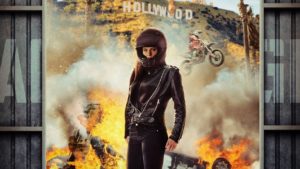
This week, a documentary called Stuntwomen: The Untold Hollywood Story is being made available for digital download. It’s a fascinating film that goes deep behind the scenes into the world of a frequently-neglected segment of an already underappreciated group so pivotal to the world of film and television: the stuntwomen.
Over the past few years, action movies and shows featuring women leads have led to the need for a more diverse group of stuntpeople, including the movies and shows from Marvel Studios like Captain Marvel and Jessica Jones, and plenty of others.
Directed by April Wright and inspired by Mollie Gregory’s book, Stuntwomen is narrated by Michelle Rodriguez from the Fast and Furious franchise – another great example of an action movie with great female roles — and it features an amazing array of women talking about their work, some of the highlights but also plenty of low points.
Below the Line had the opportunity to talk with three of the stunt performers featured in Wright’s film: Michelle Jubilee Gonzalez, Donna Keegan and Amy Johnston. Johnston has even written her own book on the subject, How to Stunt in Hollywood: Insight and Advice from World Class Stunt People.
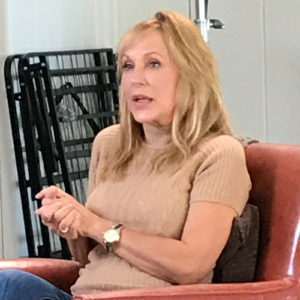
Of the three stuntwomen we spoke to, Keegan is definitely the most veteran of the group, already retired after a 28-year career that began with films like Scarface, and included stunts in an amazing run of films including Indiana Jones and the Temple of Doom, To Live and Die in L.A., Top Gun, Robocop, True Lies and much more. ” I didn’t come into the business like the majority of stuntwomen or stunt people. I don’t have family — I didn’t marry someone and I’m not somebody’s daughter or girlfriend, where you see many [come from], especially females,” she told us over the phone a few weeks back. “I was modeling in New York and starting to do some acting, and I had heard about stunts. I had been an international springboard diving champion when I was a kid, so I thought I could be an action actress and utilize all my athletic skills. Having grown up with older brothers, I learned a lot of ways to survive.”
“It was immediately obvious from the moment I saw the movie Hooper,” she continued. “I went, ‘That looks like my life. That’s the way we run in New Jersey,’ all that kind of crazy stuff, barroom brawls, etc. — not that I participated in them — but that’s a normal way of Jersey life. I just packed up one day and moved everything to California from New York City, and sought out a famous stuntman by the name of Alan Gibbs at International Stunt Association. I met him, and he introduced me while I was there to another man who was stunt coordinating a movie. I happened to be a great double for Pam Dawber, and I did that movie, and then everything snowballed after that.”

“I’ve been in the realm of performing since I was a kid,” said Gonzalez, whose skill set goes far beyond stunt work into music, but as far as the former, she’s done movies like The Fate of the Furious and the upcoming A Quiet Place, Part II. She even was a stunt capture performer for the recent The Avengers video game. “I always loved storytelling and got my first taste of performing with the violin in an opera company where — because of my background in gymnastics and martial arts — I would often have these character roles, which required me doing some flips and fights on stage. As I expanded and grew more into myself as an artist, I was like, ‘I really would love to do this on a bigger scope.’ I was watching Jackie Chan, Bruce Lee, all these incredible men doing martial arts and kicking butt. I just trained basically from childhood in gymnastics and martial arts all the way through college. After I finished my college degree, I moved to Los Angeles, where I got with a stunt specialty agency for commercials, and they referred me to Bob’s Backyard — Bob Yerkes, who was like one of the pioneers of stunts. In his backyard, I started learning how to do high falls and adapting martial arts for camera, learning about angles and hitting marks and all that good stuff. I just started networking with the right people, training with the community, and little by little, I got into the industry through a lot of hard work.”
In the doc, Johnston almost acts as the viewer’s entry into this world, being the very first person you see on screen, but then also spending time with many of the vets, including Keegan, as part of Wright’s film. “It was kind of a long process for me,” she said about her own entry into the world of stunts. “I came out with a martial arts background. My father was a kickboxing world champion, and I grew up doing martial arts in his martial arts school. That was my thing, and I watched a lot of action movies, so I wanted to get into stunts and be an action star.”
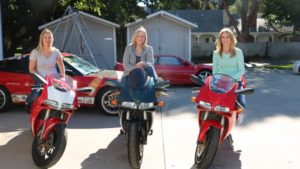
“I moved to L.A., and I had to do a lot of background work. I had to start meeting with different stunt performers, training at different gyms,” she continued. “You really have to network, because if nobody knows you exist, you’re not going to get anywhere. What really helped me was doing a lot of online fight videos, because then there’s a little bit more open for people to see my skill sets and I started getting hired, as a stunt performer and actress through fight videos online. My first real SAG job was a Disney show called Pair of Kings, and basically a coordinator just believed in me, believed in my my fight videos online after me being in LA for many years. This was kind of my first shot when somebody believed in me, and he gave me a chance and taught me the ropes. People like that I’m forever grateful for, and I hope to do that for many people coming into the industry now.”
“I’ve always done a lot of different things all at the same time. I think it’s either part of my personality and just part of what I’m used to,” Gonzalez mentioned on how she divides her times between stunts, acting and music. “I still teach music on the side, record, write songs and still do all that stuff, but that’s a supplement to the greater performance I find when being in front of the camera, whether it’s doing stunts or acting or both.”
“I don’t specialize in one skill. I often try and train in as many skills as possible,” she says about trying to diversify herself to be more employable within the stunts community. “It’s kind of like the old school mentality [to not be] a one trick pony. I think as stunt performers, the more skills you have, the more you’re going to be able to work. I started training in stunt driving, in tactical, in wirework and ratchets, in air rams and high falls and low falls and ground pound. I try everything that I can get my hands into, and everything I can get additional training into, that’s what I do. I consider myself a pretty well-rounded performer. No special niche for me — adaptability, I think, is my niche. I have to be able to adapt on the fly to all sorts of different elements that may happen on set. The more training you get, the more people will feel confident and that you will feel safe enough to do what they need you to do on set and keep everything safe.”
“To be a real asset in the business, you need to be rather diversified,” Keegan confirmed. “I would say some of my strongest things were extreme high falls, car work, I could jump cars, turn over cars, things like that. Full burns, things of that nature. The rest is just the easy stuff after that, because anything else, like falling downstairs is a given. Car hits, don’t ever want to do those again in my life. I, of course, drive motorcycles, street bikes and stuff, but when it comes to that arena, I leave it to the pros, the Debbie Evans, the Donna Evans, the Dana Dru Evenson, Jennifer Caputo, people like that for the motorcycles. Obviously fight scenes, that’s a given. If you don’t know how to do that you really shouldn’t be doing stunts. I would say that pretty much covers the gamut of things that I don’t do and nothing to do with horses. I don’t ride horses. They don’t have a kill switch.”
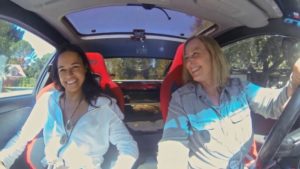
“The fighting is something that I always get hired for,” Johnston remarked. “That’s kind of the main thing I’m somewhat known for, fighting and acting and doing my own action. But then as a stunt performer or somebody in the action business, it’s really important to have different skill sets, because you’ll get hired for one thing, but then they’re going to want you to be in wirework, they may need you to drive a car. I try to maintain as many different random skill sets as I possibly can. I try to get myself into anything and everything but fighting and martial arts and acting and wirework is all my main thing.”
Gonzalez told us about a few of the sessions she did with Stuntwomen director Amy Wright to show what’s involved with prepping a stunt. “She saw how we work together as a team and she got to see us have that camaraderie that I think is a very required and important and essential to what we do as a team of performers. We want to support each other, make sure everybody feels confident on set, and the best way to do that is to prepare and to practice and train.”
One of Keegan’s big breaks came when she connected with Jamie Lee Curtis and ended up becoming her go-to stunt double for many years. “The first one I did was Mother’s Boys,” she told us. “I got that because I was at a beach club, and when both of us walked out of the bathroom stalls to the sink, she looked at me, I looked at her and she says, ‘Oh, my God, you look like my twin. You would be the perfect double for me!’ This is bathroom conversation at a beach club. I said, ‘Well, funny enough I’m the National Chair of Stunt and Safety, and I’m also a stuntwoman, a stunt coordinator and director.’ We’ve been together ever since.”
That relationship led to Keegan doubling for Curtis on James Cameron’s True Lies, and Keegan admits Cameron has been one of her favorite directors to work with. “Jim Cameron, anything that you’re going to do, he can do it. He’s phenomenal,” she told us. “He’s the most agile, aggressive director I have ever seen. He knows exactly what he wants, and he articulates it very clearly. I love James. I worked with him for over nine months on True Lies, and foolishly turned down Titanic because I had already committed to two other movies, one of which Jamie was in.” (Keegan is working on her own memoir from her time in the industry.)
Getting back to some advice from the other stuntwomen about making your way through the stunt profession, Johnston shared one insight. “The hardest thing is getting seen and letting people know that you exist and you’re safe on set and you’re nice to work with and you have these skill sets. For me, it was really just like meeting different people and training with them and showing them that I can do these things. The online video is making reels of your work and your skill set and putting that out on YouTube. That’s the biggest tool in my mind. There’s also stunt services and different areas to place your resume and try to get hired. It’s a lot of putting yourself out there and continuing to learn and really network. Networking is probably the most important thing, unfortunately.”
When asked about her own proudest moment of her illustrious career, Keegan pointed to two movies. “I’m really proud of everything that I did in Indiana Jones and the Temple of Doom. These movies were in the days where you weren’t using wires and stuff. It wasn’t the old CGI thing. There was a little bit in Indiana Jones, but the bulk of the work that made it exciting, was all the real stuff. It was very dangerous, really hard. Same thing with True Lies. Everything that I did, other than hanging from the helicopter, which of course I had to be cabled to the helicopter when I finally came out of the limo — everything else, nothing’s done with wires and CGI — that’s all real deal, nine hard months. I played 16 roles in that movie, because I was the only woman taken on the whole trip for the duration of it, so I was very satisfied with what we did there.”
“That was really my favorite part of the film and of the process,” Johnston said about her time spent with Keegan. “She’s just such a legend, and so full of spunk and life and truly inspires me to continue what I’m doing until forever, because why not? She’s doing it. She’s a total inspiration.”
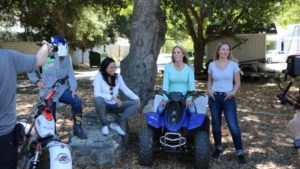
“We don’t really talk about it because we weren’t supposed to talk about it. It was just not part of the culture,” Gonzalez says about the stigma of being a stuntwoman, especially in the earlier days of cinema and even going into the ‘60s and ‘70s. “Even the male performers didn’t talk about being stunts performers, because all of the glory was supposed to go to the actors to make them look good. So many things have changed. Everybody’s getting recognized now, and there’s an appreciation and a value that comes with understanding how the magic happens. I think that’s important, because we all are part of making the magic here, which is why I think it’s so great when you have these documentaries and books written about these incredible pioneers within the industry that have completely changed the game or paved the road for us to come through, but not only paved the road by allowing us to be recognized like, ‘Oh, yeah. Women are just as tough as men and we’re just as capable of doing these things.’ There’s no reason a guy should be doubling a female. There are women who are just as skillful, so I think it’s just a matter of establishing an equal team of capable individuals, all gender aside.”
“The trend is definitely changed, but it’s still hard to get a female led action film,” Johnston opines. “We’re still working, but there’s still a lot of issues. It was interesting to me seeing how many issues they’ve overcome from the past and what the women had gone through with men getting wigged and people getting painted down with blackface. A lot of those issues still exist today. Even with so many more people in the stunt industry and so many more women and so many more people of color, we still have these issues, so there’s still a lot to work on, but it’s important to have films like this to bring everything to light. I’m so proud of this film.”
Gonzalez is still very enthusiastic about her place in the community. “There was just such an assimilation and such a vibe of curiosity to always learn, to figure out the mechanics of stunts that I think stunt people share, it really resonated with me, and the joy that we had in exploring and discovering what works and what doesn’t work, I was just so in tune to that. I just felt right at home with this community of active storytellers.”
Of the two working stuntwomen, COVID-19 has been particularly challenging in terms of the work just stopping. “It’s been a lot of different challenges across the board, even training. Where can you train when everything is shut down?” Gonzalez asked. “To answer that question is a little difficult just because we’ve been very limited with what we can do, considering the circumstances. You have to take precautions.
“Thankfully, I can do a lot of motion capture for video games, which I’ve been doing for several years now,” Johnston agrees. “Because you only need one actor on the stage and you only need one technician. You do a bunch of movements, the cameras capture movements and put those onto different characters. They do the COVID safety test, you quarantine, and there’s a COVID officer on set. I’m actually getting ready to go to Hawaii right now where there’s quarantining for two weeks.”
“I think the majority of us were trying to be careful with just learning about COVID just the way everybody else was,” Gonzalez continued. “You’re not going to do the same stuff and be boxing and doing wrestling and sweating. You’re not gonna shed germs that close when there’s a giant germ floating around – a little bit of common sense is necessary. It’s not easy, because training is also such an important part of my own mental health. Like that’s a really important outlet, but I feel like I’m being proactive in my career and I’m taking care of myself and I have a positive productive outlet to use my body and my energy. Not being able to train the way that I was before has been very taxing on me.”
Stuntwomen: The Untold Hollywood Story is available via most digital platforms, and you can watch the trailer below:





